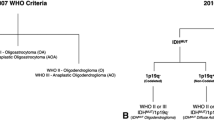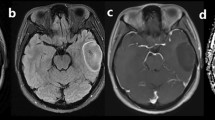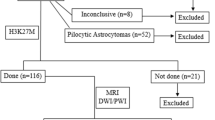Abstract
Objectives
A combination of T2/FLAIR mismatch sign and advanced imaging parameters may improve the determination of molecular subtypes of diffuse lower-grade glioma. We assessed the diagnostic value of adding the apparent diffusion coefficient (ADC) and cerebral blood volume (CBV) to the T2/FLAIR mismatch sign for differentiation of the IDH mutation or 1p/19q codeletion.
Materials and methods
Preoperative conventional, diffusion-weighted, and dynamic susceptibility contrast imaging were performed on 110 patients with diffuse lower-grade gliomas. The study population was classified into three groups using molecular subtype, namely IDH mutation and 1p/19q codeletion (IDHmut-Codel), IDH wild type (IDHwt) and IDH mutation and no 1p/19q codeletion (IDHmut-Noncodel). T2/FLAIR mismatch sign and the histogram parameters of apparent diffusion coefficient (ADC) and normalised cerebral blood volume (nCBV) values were assessed. A multivariate logistic regression model was constructed to distinguish IDHmut-Noncodel from IDHmut-Codel and IDHwt and from IDHwt, and the performance was compared with that of single parameters using the area under the receiver operating characteristics curve (AUC).
Results
Positive visual T2/FLAIR mismatch sign and higher nCBV skewness were significant variables to distinguish IDHmut-Noncodel from the other two groups (AUC, 0.88; 95% CI, 0.81–0.96). A lower ADC10 was a significant variable for distinguishing IDHmut-Noncodel from the IDHwt group (AUC, 0.75; 95% CI, 0.62–0.89). Adding ADC or CBV histogram parameters to T2/FLAIR mismatch sign improved performance in distinguishing IDHmut-Noncodel from the other two groups (AUC 0.882 vs. AUC 0.810) or from IDHwt (AUC 0.923 vs. AUC 0.868).
Conclusions
The combination of the T2/FLAIR mismatch sign with ADC or CBV histogram parameters can improve the identification of IDHmut-Noncodel diffuse lower-grade gliomas, which can be easily applied in clinical practice.
Key Points
• The combination of the T2/FLAIR mismatch sign with the ADC or CBV histogram parameters can improve the identification of IDHmut-Noncodel diffuse lower-grade gliomas.
• The multivariable model showed a significantly better performance for distinguishing the IDHmut-Noncodel group from other diffuse lower-grade gliomas than the T2/FLAIR mismatch sign alone or any single parameter.
• The IDHmut-Noncodel type was associated with intermediate treatment outcomes; therefore, the identification of IDHmut-Noncodel diffuse lower-grade gliomas could be helpful for determining the clinical approach.




Similar content being viewed by others
Abbreviations
- AUC:
-
Area under the receiver operating characteristics curve
- DSC:
-
Dynamic susceptibility contrast imaging
- DWI:
-
Diffusion-weighted imaging
- ICC:
-
Intra-class correlation coefficient
- IDH:
-
Isocitrate dehydrogenase
- IDHmut-Codel:
-
IDH mutant with 1p/19q codeletion subtype of diffuse lower-grade glioma
- IDHmut-Noncodel:
-
IDH mutant with no 1p/19q codeletion subtype of diffuse lower-grade glioma
- IDHwt:
-
IDH wild type of diffuse lower-grade glioma
References
Brat DJ, Verhaak RG, Aldape KD et al (2015) Comprehensive, integrative genomic analysis of diffuse lower-grade gliomas. N Engl J Med 372:2481–2498
Eckel-Passow JE, Lachance DH, Molinaro AM et al (2015) Glioma groups based on 1p/19q, IDH, and TERT promoter mutations in tumors. 372:2499–2508
Leu K, Ott GA, Lai A et al (2017) Perfusion and diffusion MRI signatures in histologic and genetic subtypes of WHO grade II–III diffuse gliomas. J Neurooncol 134:177–188
Patel SH, Poisson LM, Brat DJ et al (2017) T2–FLAIR mismatch, an imaging biomarker for IDH and 1p/19q status in lower-grade gliomas: a TCGA/TCIA project. Clin Cancer Res 23:6078–6085
van den Bent MJ, Smits M, Kros JM, Chang SM (2017) Diffuse infiltrating oligodendroglioma and astrocytoma. J Clin Oncol 35:2394–2401
Van den Bent MJ, Looijenga LH, Langenberg K et al (2003) Chromosomal anomalies in oligodendroglial tumors are correlated with clinical features. Cancer 97:1276–1284
Nobusawa S, Watanabe T, Kleihues P, Ohgaki H (2009) IDH1 mutations as molecular signature and predictive factor of secondary glioblastomas. Clin Cancer Res 15:6002–6007
Kickingereder P, Sahm F, Radbruch A et al (2015) IDH mutation status is associated with a distinct hypoxia/angiogenesis transcriptome signature which is non-invasively predictable with rCBV imaging in human glioma. Sci Rep 5:16238
Chen L, Liu M, Bao J et al (2013) The correlation between apparent diffusion coefficient and tumor cellularity in patients: a meta-analysis. PLoS One 8:e79008
Xing Z, Yang X, She D, Lin Y, Zhang Y, Cao D (2017) Noninvasive assessment of IDH mutational status in World Health Organization grade II and III astrocytomas using DWI and DSC-PWI combined with conventional MR imaging. AJNR Am J Neuroradiol 38:1138–1144
Coons SW, Johnson PC, Scheithauer BW, Yates AJ, Pearl DK (1997) Improving diagnostic accuracy and interobserver concordance in the classification and grading of primary gliomas. Cancer 79:1381–1393
van den Bent MJ (2010) Interobserver variation of the histopathological diagnosis in clinical trials on glioma: a clinician’s perspective. Acta Neuropathol 120:297–304
Siegal T (2016) Clinical relevance of prognostic and predictive molecular markers in gliomas. Adv Tech Stand Neurosurg. https://doi.org/10.1007/978-3-319-21359-0_4:91-108
Lai A, Kharbanda S, Pope WB et al (2011) Evidence for sequenced molecular evolution of IDH1 mutant glioblastoma from a distinct cell of origin. J Clin Oncol 29:4482–4490
Weisskoff R, Boxerman J, Sorensen A, Kulke S, Campbell T, Rosen B (1994) Simultaneous blood volume and permeability mapping using a single Gd-based contrast injection. Proceedings of the Society of Magnetic Resonance, Second Annual Meeting, pp 6–12
Boxerman J, Schmainda K, Weisskoff R (2006) Relative cerebral blood volume maps corrected for contrast agent extravasation significantly correlate with glioma tumor grade, whereas uncorrected maps do not. AJNR Am J Neuroradiol 27:859–867
Broen MP, Smits M, Wijnenga MM et al (2018) The T2-FLAIR mismatch sign as an imaging marker for non-enhancing IDH-mutant, 1p/19q-intact lower-grade glioma: a validation study. Neuro Oncol 20:1393–1399
Maes F, Collignon A, Vandermeulen D, Marchal G, Suetens P (1997) Multimodality image registration by maximization of mutual information. IEEE Trans Med Imaging 16:187–198
Chung WJ, Kim HS, Kim N, Choi CG, Kim SJ (2013) Recurrent glioblastoma: optimum area under the curve method derived from dynamic contrast-enhanced T1-weighted perfusion MR imaging. Radiology 269:561–568
Delgado-López P, Corrales-García E, Martino J, Lastra-Aras E, Dueñas-Polo MT (2017) Diffuse low-grade glioma: a review on the new molecular classification, natural history and current management strategies. Clin Transl Oncol 19:931–944
Koeller KK, Rushing EJ (2005) Oligodendroglioma and its variants: radiologic-pathologic correlation. Radiographics 25:1669–1688
Lee S, Choi SH, Ryoo I et al (2015) Evaluation of the microenvironmental heterogeneity in high-grade gliomas with IDH1/2 gene mutation using histogram analysis of diffusion-weighted imaging and dynamic-susceptibility contrast perfusion imaging. J Neurooncol 121:141–150
Tan WL, Huang WY, Yin B, Xiong J, Wu JS, Geng DY (2014) Can diffusion tensor imaging noninvasively detect IDH1 gene mutations in astrogliomas? A retrospective study of 112 cases. AJNR Am J Neuroradiol 35:920–927
Jenkinson MD, Smith TS, Brodbelt AR, Joyce KA, Warnke PC, Walker C (2007) Apparent diffusion coefficients in oligodendroglial tumors characterized by genotype. J Magn Reson Imaging 26:1405–1412
Chawla S, Krejza J, Vossough A et al (2013) Differentiation between oligodendroglioma genotypes using dynamic susceptibility contrast perfusion-weighted imaging and proton MR spectroscopy. AJNR Am J Neuroradiol 34:1542–1549
Bankier AA, Levine D, Halpern EF, Kressel HY (2010) Consensus interpretation in imaging research: is there a better way? Radiology 257:14–17
Cohen AL, Holmen SL, Colman H (2013) IDH1 and IDH2 mutations in gliomas. Curr Neurol Neurosci Rep 13:345
Park SH, Han K (2018) Methodologic guide for evaluating clinical performance and effect of artificial intelligence technology for medical diagnosis and prediction. Radiology 286:800–809
Funding
This research was supported by the Basic Science Research Program through the National Research Foundation of Korea (NRF) funded by the Ministry of Education, Science and Technology (grant number, NRF-2017R1A2A2A05001217) and by a grant (2017-7030) from the Asan Institute for Life Sciences, Asan Medical Center, Seoul, Korea. The funders had no role in study design, data collection and analysis, decision to publish or preparation of the manuscript.
Author information
Authors and Affiliations
Corresponding author
Ethics declarations
Guarantor
The scientific guarantor of this publication is Ho Sung Kim.
Conflict of interest
The authors of this manuscript declare no relationships with any companies, whose products or services may be related to the subject matter of the article.
Statistics and biometry
One of the authors has significant statistical expertise: Seo Young Park.
Informed consent
Written informed consent was waived by the Institutional Review Board.
Ethical approval
Institutional Review Board approval was obtained.
Methodology
• retrospective
• cross-sectional study
• performed at one institution
Additional information
Publisher’s note
Springer Nature remains neutral with regard to jurisdictional claims in published maps and institutional affiliations.
Electronic supplementary material
ESM 1
(DOCX 16 kb)
Rights and permissions
About this article
Cite this article
Lee, M.K., Park, J.E., Jo, Y. et al. Advanced imaging parameters improve the prediction of diffuse lower-grade gliomas subtype, IDH mutant with no 1p19q codeletion: added value to the T2/FLAIR mismatch sign. Eur Radiol 30, 844–854 (2020). https://doi.org/10.1007/s00330-019-06395-2
Received:
Revised:
Accepted:
Published:
Issue Date:
DOI: https://doi.org/10.1007/s00330-019-06395-2




